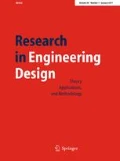Abstract
Creative ideas are essential to original concept generation and ultimately innovation. But where and when do these vital creative ideas occur during product innovation and more importantly how can they be influenced? The following paper describes an industrially based study of several innovation projects following the actual processes of professional designers. Some ideas from the early brainstorm can be traced all the way through to concepts that are selected at the company’s stage-gate. Those early ideas are marked as ‘appropriate’ which provides an objective evaluation of the influence of any prescribed creative stimuli being used during the brainstorm sessions in relation to the output of the innovation process. The results showed that the frequency of idea production remained roughly constant during the first 30 min but steadily reduced after this period. However, the number of ‘appropriate’ ideas decreased rapidly, where 75% of the appropriate ideas in the first 30 min had been expressed after just 15 min. By introducing various forms of stimuli to the groups, the frequency of idea generation was maintained and in many cases increased. The stimuli were also shown to help generate more appropriate ideas which were included within concepts proposed at the stage-gate.










Similar content being viewed by others
References
Adair JG, Sharpe D, Huynh CL (1990) The placebo control group: an analysis of its effectiveness in educational research. Journal of Experimental Education 59(1):p67–p86
Altshuller GS (1999) The innovation algorithm: TRIZ, systematic innovation and technical creativity. Technical Innovation Center, Worcester, Mass
Benami O, Jin Y (2002) Creative stimulation in engineering design. DETC2002/DTM-34023, ASME 2002 Design Engineering Technical Conferences and Computer and Information in Engineering Conference. Montreal, Canada
BS7000 (2008) Design management systems part 2. Guide to managing the design of manufactured products. British Standards. London, BSI. BS7000-2:2008
Cox G (2005) Cox review of creativity in business: building on the UK’s strengths. Independent reviews, from http://www.hm-treasury.gov.uk/independent_reviews/cox_review/coxreview_index.cfm
Faure C (2004) Beyond brainstorming: effects of different group procedures on selection of ideas and satisfaction with the process. J Creat Behav 38(1):13–34
Gero JS (1996) Creativity, emergence and evolution in design. Knowl-Based syst 9(7):435–448
Gero JS (2004) The situated function–behaviour–structure framework. Des Stud 25(4):373–391
Hatchuel A, Weil B (2009) C-K design theory: an advanced formulation. Res Eng Design 19:181–192
Helquist HJ, Santanen EL, Kruse J (2007). Participant-driven GSS: quality of brainstorming and allocation of participant resources. 40th Annual Hawaii international conference on system sciences, IEEE Computer
Howard TJ (2008) Information Management for Creative Stimuli in Engineering Design. Mechanical Engineering. University of Bath, Bath, p 171
Howard TJ, Culley SJ, Dekoninck EA (2006). Information as an input into the creative process. 9th International design conference DESIGN 06, Dubrovnik
Howard TJ, Culley SJ, Dekoninck EA (2008) Describing the creative design process by the integration of engineering design and cognitive psychology literature. Des Stud 29(2):160–180
Howard TJ, Culley SJ, Dekoninck EA (2010). Reuse of ideas and concepts for creative stimuli in engineering design. J Eng Design. doi:10.1080/09544821003598573
Isaksen SG, Gaulin JP (2005) A reexamination of brainstorming research: implications for research and practice. Gifted Child Quarterly 49(4):315–329
Jones E, Stanton NA, Harrison D (2001) Applying structured methods to eco-innovation. An evaluation of the product ideas tree diagram. Des Stud 22(6):519–542
Kim Y, Jin S, Lee H (2005) Dual protocol analysis based on design information and design process: a case study. Studying designers ‘05. Key centre of design computing and cognition, University of Sydney
Kristensson P, Norlander T (2003) The creative product and the creative processes in virtual environments. Creat Innov Manage 12(1):32–40
Liikkanen LA, Perttula M (2006) Contextual cueing and verbal stimuli in design idea generation. In: Gero JS (ed) Design computing and cognition '06. Springer, Eindhoven, pp 619–631
Mak TW, Shu LH (2008) Using descriptions of biological phenomena for idea generation. Res Eng Design 19:21–28
Massetti B (1996) An empirical examination of the value of creativity support systems on idea generation. MIS Quarterly 20(1):83–97
McAdams DA, Wood KL (2002) A quantitative similarity metric for design-by-analogy. J Mech Des 124:173–182
Mulet E, Vidal R (2008) Heuristic guidelines to support conceptual design. Res Eng Design 19:101–112
Napier N, Nilsson M (2006) The development of creative capabilities in and out of creative organizations: three case studies. Creat Innov Manage 15(3):268–278
Nijstad BA, Stroebe W, Lodewijkx HFM (2002) Cognitive stimulation and interference in groups: exposure effects in an idea generation task. J Exp Soc Psychol 38(16):535–544
Osborn AF (1953) Applied imagination; principles and procedures of creative thinking. Scribner, New York
Perttula M, Sipila P (2007) The idea exposure paradigm in design idea generation. J Eng Des 18(1):93–102
Sainsbury D (2007) Sainsbury Review of Science and Innovation. Independent reviews. H. Treasury. HM Treasury: Article, London
Shah J, Vargas-Hernandez N (2003) Metrics for measuring ideation effectiveness. Des Stud 24(2):111–134
Thagard P (1997). Medical analogies: why and how? Proceedings of the nineteenth annual conference of the cognitive science society. Erlbaum, Mahway
Wierenga B (1998) The dependent variable in research into the effects of creativity support systems: quality and quantity of ideas. MIS Quarterly 22(1):89–93
Xu QL, Ong SK, Nee AYC (2006) Function-based design synthesis approach to design reuse. Res Eng Design 17:27–44
Acknowledgments
The work reported in this paper has been undertaken as part of the EPSRC Innovative Design and Manufacturing Research Centre at The University of Bath (grant reference EP/E00184X/1).
Author information
Authors and Affiliations
Corresponding author
Rights and permissions
About this article
Cite this article
Howard, T.J., Dekoninck, E.A. & Culley, S.J. The use of creative stimuli at early stages of industrial product innovation. Res Eng Design 21, 263–274 (2010). https://doi.org/10.1007/s00163-010-0091-4
Received:
Accepted:
Published:
Issue Date:
DOI: https://doi.org/10.1007/s00163-010-0091-4




